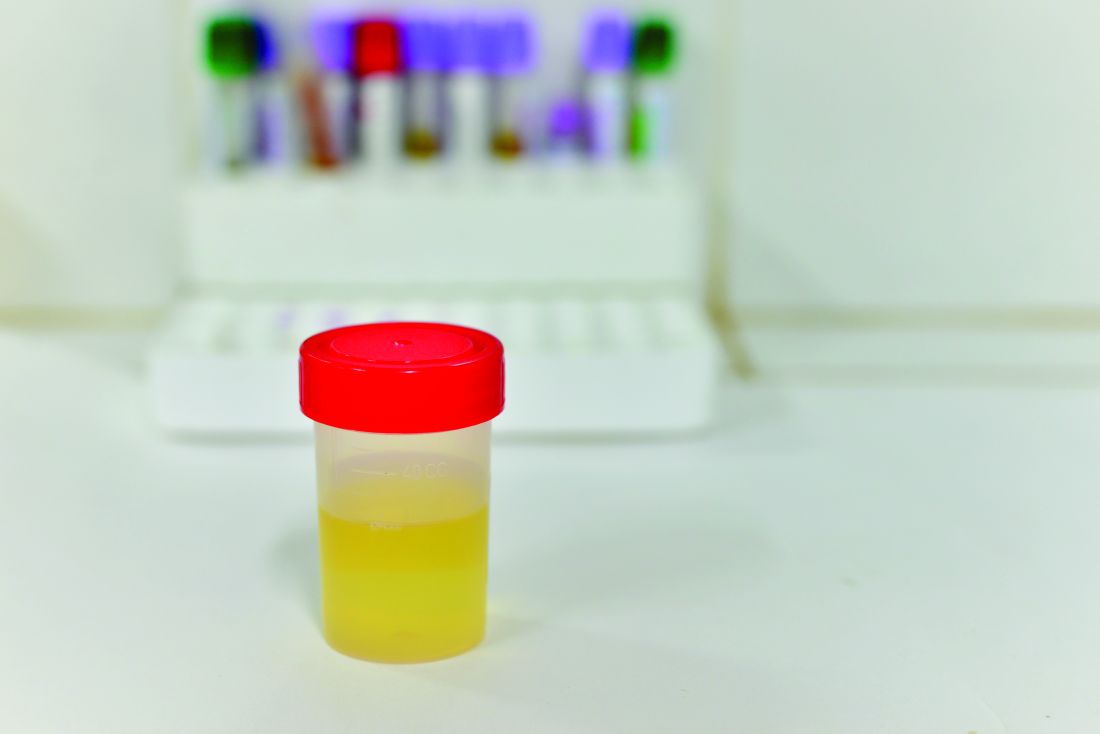User login
HIV antiretroviral resistance can affect more than 10% of pregnant women
SAN DIEGO – HIV antiretroviral resistance can affect more than 10% of pregnant women, even if they are previously treatment naive, results of a case-control study demonstrated.
“Furthermore, if there is an HIV-infected infant who received HIV prophylaxis with zidovudine and nevirapine, the infant may have developed resistance to the nonnucleoside reverse transcriptase inhibitors [NNRTIs] class of medications, and timely antiretroviral-resistant testing is an important step prior to choosing an appropriate regimen,” Nava Yeganeh, MD, said in an interview prior to an annual scientific meeting on infectious diseases.
In all, 140 infants were HIV infected, and 13 had drug-resistant mutations. Of the 606 women who had sufficient nucleic acid amplification for resistance testing, 63 (10.4%) had drug-resistant mutations against one or more classes of antiretrovirals. “These mothers may have been infected with a drug-resistant strain of HIV, which they then may have passed on to their infants,” Dr. Yeganeh said. “We also found that 3 of the 13 HIV-infected infants with drug-resistant mutations against NNRTIs were born to mothers who did not have a resistant strain of HIV. These three infants likely developed resistance because of the infant prophylaxis they received with nevirapine.”
Univariate and multivariate analyses revealed that drug-resistant mutation in mothers was not associated with increased risk of HIV mother-to-child transmission (adjusted odds ratio, 0.79). The only predictors of mother-to-child transmission were log HIV viral load (OR, 1.4) and infant prophylaxis arm with a two-drug regimen (OR, 1.6). In addition, the presence of drug-resistant mutations in mothers who transmitted was strongly associated with presence of drug-resistant mutations in infants (P less than .001).
A key limitation of the trial, Dr. Yeganeh said, was that it was completed in 2011. “Antiretroviral-resistant HIV may be even more common now that antiretrovirals are more available,” she said at the combined annual meetings of the Infectious Diseases Society of America, the Society for Healthcare Epidemiology of America, the HIV Medicine Association, and the Pediatric Infectious Diseases Society. She reported having no financial disclosures.
SAN DIEGO – HIV antiretroviral resistance can affect more than 10% of pregnant women, even if they are previously treatment naive, results of a case-control study demonstrated.
“Furthermore, if there is an HIV-infected infant who received HIV prophylaxis with zidovudine and nevirapine, the infant may have developed resistance to the nonnucleoside reverse transcriptase inhibitors [NNRTIs] class of medications, and timely antiretroviral-resistant testing is an important step prior to choosing an appropriate regimen,” Nava Yeganeh, MD, said in an interview prior to an annual scientific meeting on infectious diseases.
In all, 140 infants were HIV infected, and 13 had drug-resistant mutations. Of the 606 women who had sufficient nucleic acid amplification for resistance testing, 63 (10.4%) had drug-resistant mutations against one or more classes of antiretrovirals. “These mothers may have been infected with a drug-resistant strain of HIV, which they then may have passed on to their infants,” Dr. Yeganeh said. “We also found that 3 of the 13 HIV-infected infants with drug-resistant mutations against NNRTIs were born to mothers who did not have a resistant strain of HIV. These three infants likely developed resistance because of the infant prophylaxis they received with nevirapine.”
Univariate and multivariate analyses revealed that drug-resistant mutation in mothers was not associated with increased risk of HIV mother-to-child transmission (adjusted odds ratio, 0.79). The only predictors of mother-to-child transmission were log HIV viral load (OR, 1.4) and infant prophylaxis arm with a two-drug regimen (OR, 1.6). In addition, the presence of drug-resistant mutations in mothers who transmitted was strongly associated with presence of drug-resistant mutations in infants (P less than .001).
A key limitation of the trial, Dr. Yeganeh said, was that it was completed in 2011. “Antiretroviral-resistant HIV may be even more common now that antiretrovirals are more available,” she said at the combined annual meetings of the Infectious Diseases Society of America, the Society for Healthcare Epidemiology of America, the HIV Medicine Association, and the Pediatric Infectious Diseases Society. She reported having no financial disclosures.
SAN DIEGO – HIV antiretroviral resistance can affect more than 10% of pregnant women, even if they are previously treatment naive, results of a case-control study demonstrated.
“Furthermore, if there is an HIV-infected infant who received HIV prophylaxis with zidovudine and nevirapine, the infant may have developed resistance to the nonnucleoside reverse transcriptase inhibitors [NNRTIs] class of medications, and timely antiretroviral-resistant testing is an important step prior to choosing an appropriate regimen,” Nava Yeganeh, MD, said in an interview prior to an annual scientific meeting on infectious diseases.
In all, 140 infants were HIV infected, and 13 had drug-resistant mutations. Of the 606 women who had sufficient nucleic acid amplification for resistance testing, 63 (10.4%) had drug-resistant mutations against one or more classes of antiretrovirals. “These mothers may have been infected with a drug-resistant strain of HIV, which they then may have passed on to their infants,” Dr. Yeganeh said. “We also found that 3 of the 13 HIV-infected infants with drug-resistant mutations against NNRTIs were born to mothers who did not have a resistant strain of HIV. These three infants likely developed resistance because of the infant prophylaxis they received with nevirapine.”
Univariate and multivariate analyses revealed that drug-resistant mutation in mothers was not associated with increased risk of HIV mother-to-child transmission (adjusted odds ratio, 0.79). The only predictors of mother-to-child transmission were log HIV viral load (OR, 1.4) and infant prophylaxis arm with a two-drug regimen (OR, 1.6). In addition, the presence of drug-resistant mutations in mothers who transmitted was strongly associated with presence of drug-resistant mutations in infants (P less than .001).
A key limitation of the trial, Dr. Yeganeh said, was that it was completed in 2011. “Antiretroviral-resistant HIV may be even more common now that antiretrovirals are more available,” she said at the combined annual meetings of the Infectious Diseases Society of America, the Society for Healthcare Epidemiology of America, the HIV Medicine Association, and the Pediatric Infectious Diseases Society. She reported having no financial disclosures.
AT IDWEEK 2017
Key clinical point:
Major finding: Of 606 women who had sufficient nucleic acid amplification for resistance testing, 63 (10.4%) had drug-resistant mutations against one or more classes of antiretrovirals.
Study details: A case-control study of blood samples from 606 HIV-infected pregnant women and their infants.
Disclosures: Dr. Yeganeh reported having no financial disclosures.
Expanding treatment options to deal with antibiotic resistance
SAN DIEGO – In an era of rising antibiotic resistance, new potential treatment options and policy changes took the stage at the start of an annual scientific meeting on infectious diseases.
Presenters covered emerging topics addressing infectious diseases, with a strong focus on HIV. A common emphasis, among all presentations, was the pressing need to update availability of newer and more effective drugs.
“There’s always something hot in ID, and often it’s transient. But what isn’t transient is the overwhelming problem of antibiotic resistance,” said Stan Deresinski, MD, infectious disease specialist from Stanford (Calif.) University. He added that: “A fear come true is the merger of antibiotic resistance and increased virulence.”
While long-term solutions are needed, a short-term answer is the increase in the kinds of antibiotics available, Dr. Deresinski said.
“As we look at this sort of event, we begin to look at ourselves in the near future as plague doctors,” warned Dr. Deresinski. “We need to deal with this, and the thing that can be done in the short term is the development of new antibiotics.”
The Food and Drug Administration has several avenues that could be used to provide for expedited antibiotics approval, such as fast tracking and priority approval of drugs. An additional program called Generating Antibiotic Incentives Now (GAIN) that allows the FDA to designate an antibiotic as an anti-infectious disease product, making it eligible for fast tracking and priority approval, as well as the addition of 5 years of market exclusivity, may be used to incentivize the development of newer drugs.
In addition, Combating Antibiotic Resistant Bacteria Biopharmaceutical Accelerator (CARB-X) and the Antibacterial Resistance Leadership Group (ARLG) are two groups that will be essential for accelerating antibiotic development, Dr. Deresinski said.
CARB-X, which is a public-private partnership created by a White House executive order in 2014, focuses on preclinical discovery and development, and ARLG works under the mission statement, “prioritize, design, and execute clinical research that will reduce public health threat of antibacterial resistance.”
Among the hot topics in HIV, presenters described a series of studies conducted throughout the year assessing prexposure prophylaxis (PrEP), and how interventions, such as the use of the drug tenofovir, can increase efficacy of oral prophylaxis in preventing HIV-1 transmission.
In a test of antiretroviral therapy, the use of long-acting intramuscular injectable therapy every 4 and 8 weeks had huge improvement in patient approval, 88% and 89% respectively, compared with the 43% approval rate that oral HIV-1 medications received, said Wendy Armstrong, MD, of Emory University, Atlanta.
“[This] therapy is really getting to the point that we dreamed of 25 years ago, when our goals were finding an effective agent: to have simple agents, less frequent dosing schemes, limited adverse effects, and limited drug-to-drug interaction,” said Dr. Armstrong.
Among other topics to be addressed at the conference, Dr. Deresinski noted that the recent drop in Zika infections, as well as an uptick seen in hepatitis A outbreaks among the homeless and drug-user populations, would be discussed later in the week.
ezimmerman@frontlinemedcom.com
On Twitter @eaztweets
SAN DIEGO – In an era of rising antibiotic resistance, new potential treatment options and policy changes took the stage at the start of an annual scientific meeting on infectious diseases.
Presenters covered emerging topics addressing infectious diseases, with a strong focus on HIV. A common emphasis, among all presentations, was the pressing need to update availability of newer and more effective drugs.
“There’s always something hot in ID, and often it’s transient. But what isn’t transient is the overwhelming problem of antibiotic resistance,” said Stan Deresinski, MD, infectious disease specialist from Stanford (Calif.) University. He added that: “A fear come true is the merger of antibiotic resistance and increased virulence.”
While long-term solutions are needed, a short-term answer is the increase in the kinds of antibiotics available, Dr. Deresinski said.
“As we look at this sort of event, we begin to look at ourselves in the near future as plague doctors,” warned Dr. Deresinski. “We need to deal with this, and the thing that can be done in the short term is the development of new antibiotics.”
The Food and Drug Administration has several avenues that could be used to provide for expedited antibiotics approval, such as fast tracking and priority approval of drugs. An additional program called Generating Antibiotic Incentives Now (GAIN) that allows the FDA to designate an antibiotic as an anti-infectious disease product, making it eligible for fast tracking and priority approval, as well as the addition of 5 years of market exclusivity, may be used to incentivize the development of newer drugs.
In addition, Combating Antibiotic Resistant Bacteria Biopharmaceutical Accelerator (CARB-X) and the Antibacterial Resistance Leadership Group (ARLG) are two groups that will be essential for accelerating antibiotic development, Dr. Deresinski said.
CARB-X, which is a public-private partnership created by a White House executive order in 2014, focuses on preclinical discovery and development, and ARLG works under the mission statement, “prioritize, design, and execute clinical research that will reduce public health threat of antibacterial resistance.”
Among the hot topics in HIV, presenters described a series of studies conducted throughout the year assessing prexposure prophylaxis (PrEP), and how interventions, such as the use of the drug tenofovir, can increase efficacy of oral prophylaxis in preventing HIV-1 transmission.
In a test of antiretroviral therapy, the use of long-acting intramuscular injectable therapy every 4 and 8 weeks had huge improvement in patient approval, 88% and 89% respectively, compared with the 43% approval rate that oral HIV-1 medications received, said Wendy Armstrong, MD, of Emory University, Atlanta.
“[This] therapy is really getting to the point that we dreamed of 25 years ago, when our goals were finding an effective agent: to have simple agents, less frequent dosing schemes, limited adverse effects, and limited drug-to-drug interaction,” said Dr. Armstrong.
Among other topics to be addressed at the conference, Dr. Deresinski noted that the recent drop in Zika infections, as well as an uptick seen in hepatitis A outbreaks among the homeless and drug-user populations, would be discussed later in the week.
ezimmerman@frontlinemedcom.com
On Twitter @eaztweets
SAN DIEGO – In an era of rising antibiotic resistance, new potential treatment options and policy changes took the stage at the start of an annual scientific meeting on infectious diseases.
Presenters covered emerging topics addressing infectious diseases, with a strong focus on HIV. A common emphasis, among all presentations, was the pressing need to update availability of newer and more effective drugs.
“There’s always something hot in ID, and often it’s transient. But what isn’t transient is the overwhelming problem of antibiotic resistance,” said Stan Deresinski, MD, infectious disease specialist from Stanford (Calif.) University. He added that: “A fear come true is the merger of antibiotic resistance and increased virulence.”
While long-term solutions are needed, a short-term answer is the increase in the kinds of antibiotics available, Dr. Deresinski said.
“As we look at this sort of event, we begin to look at ourselves in the near future as plague doctors,” warned Dr. Deresinski. “We need to deal with this, and the thing that can be done in the short term is the development of new antibiotics.”
The Food and Drug Administration has several avenues that could be used to provide for expedited antibiotics approval, such as fast tracking and priority approval of drugs. An additional program called Generating Antibiotic Incentives Now (GAIN) that allows the FDA to designate an antibiotic as an anti-infectious disease product, making it eligible for fast tracking and priority approval, as well as the addition of 5 years of market exclusivity, may be used to incentivize the development of newer drugs.
In addition, Combating Antibiotic Resistant Bacteria Biopharmaceutical Accelerator (CARB-X) and the Antibacterial Resistance Leadership Group (ARLG) are two groups that will be essential for accelerating antibiotic development, Dr. Deresinski said.
CARB-X, which is a public-private partnership created by a White House executive order in 2014, focuses on preclinical discovery and development, and ARLG works under the mission statement, “prioritize, design, and execute clinical research that will reduce public health threat of antibacterial resistance.”
Among the hot topics in HIV, presenters described a series of studies conducted throughout the year assessing prexposure prophylaxis (PrEP), and how interventions, such as the use of the drug tenofovir, can increase efficacy of oral prophylaxis in preventing HIV-1 transmission.
In a test of antiretroviral therapy, the use of long-acting intramuscular injectable therapy every 4 and 8 weeks had huge improvement in patient approval, 88% and 89% respectively, compared with the 43% approval rate that oral HIV-1 medications received, said Wendy Armstrong, MD, of Emory University, Atlanta.
“[This] therapy is really getting to the point that we dreamed of 25 years ago, when our goals were finding an effective agent: to have simple agents, less frequent dosing schemes, limited adverse effects, and limited drug-to-drug interaction,” said Dr. Armstrong.
Among other topics to be addressed at the conference, Dr. Deresinski noted that the recent drop in Zika infections, as well as an uptick seen in hepatitis A outbreaks among the homeless and drug-user populations, would be discussed later in the week.
ezimmerman@frontlinemedcom.com
On Twitter @eaztweets
AT IDWEEK 2017
High percentage of nursing home residents found to harbor MDROs
SAN DIEGO – Nearly half of nursing home residents harbored multi-drug resistant organisms on their skin, results from a large multi-center surveillance study showed.
“Residents in skilled nursing homes are the most vulnerable patients in the health care system,” lead study author James A. McKinnell, MD, said in an interview in advance of an annual scientific meeting on infectious diseases. “Many residents depend on help from health care workers for routine needs like eating or bathing. Skilled nursing facilities have an obligation to optimize the personal hygiene and environmental cleanliness in skilled nursing facilities.”

The researchers obtained 2,797 body swabs from 1,400 residents in all. Swabs were processed for methicillin-resistant Staphylococcus aureus (MRSA), vancomycin-resistant Enterococcus spp. (VRE), extended spectrum beta-lactamase producers (ESBLs), and carbapenem-resistant Enterobacteriaceae (CRE). “MRSA is a relatively well known bacteria, but CRE is the new pathogen that the CDC has defined as an urgent public health threat,” Dr. McKinnell said.
The researchers also conducted environmental surveillance of commonly touched items in skilled nursing facilities. The five surfaces tested in resident rooms were the bedside table, TV remote, door knobs, light switch, and bathrooms. The five surfaces tested in common areas were the nursing station counter, tables, chairs, hallway hand rails, and drinking fountains.
Overall, 49% of residents harbored MDROs. MRSA was found in 37% of residents, followed by ESBL in 16%, VRE in 7%, and CRE in 1%. Resident MDRO status was known for 11% of MRSA carriers, compared with 18% of ESBL, 4% of VRE, and none of the CRE carriers. Rates of colonization did not differ whether residents had long stays at the facility or postacute stays (49% vs. 48%, respectively), but bed-bound residents were more likely to be MDRO colonized, compared with ambulatory residents (59% vs. 46%; P less than .001). In the analysis of environmental swabs, 93% of common areas and 74% of resident rooms had an MDRO-positive object, with an average of 2.5 and 1.9 objects, respectively, found to be contaminated.
“The fact that about half of patients were carrying a bacteria that could cause infection on their skin was very high,” said Dr. McKinnell, who is a member of the Infectious Disease Clinical Outcome Research Unit at the Los Angeles Biomedical Research Institute at Harbor-UCLA. “Studies conducted in other care settings, we would typically see less than a quarter of patients carry these types of bacteria. I was also surprised to see that 1% of patients were carrying the CRE bacteria on their skin.”
He acknowledged certain limitations of the study, including the fact that the data were taken from a select group of nursing homes that are participating in an interventional study to improve personal hygiene for skilled nursing facility residents. “They may not be representative of all skilled nursing facilities,” he said.
The Agency for Healthcare Research and Quality funded the study. Dr. McKinnell disclosed that he is conducting studies in health care facilities with products supplied from 3M, Clorox, Sage, and Xttrium Laboratories. Many of his coauthors disclosed numerous financial ties to the pharmaceutical industry. The event was the combined annual meetings of the Infectious Diseases Society of America, the Society for Healthcare Epidemiology of America, the HIV Medicine Association, and the Pediatric Infectious Diseases Society.
SAN DIEGO – Nearly half of nursing home residents harbored multi-drug resistant organisms on their skin, results from a large multi-center surveillance study showed.
“Residents in skilled nursing homes are the most vulnerable patients in the health care system,” lead study author James A. McKinnell, MD, said in an interview in advance of an annual scientific meeting on infectious diseases. “Many residents depend on help from health care workers for routine needs like eating or bathing. Skilled nursing facilities have an obligation to optimize the personal hygiene and environmental cleanliness in skilled nursing facilities.”

The researchers obtained 2,797 body swabs from 1,400 residents in all. Swabs were processed for methicillin-resistant Staphylococcus aureus (MRSA), vancomycin-resistant Enterococcus spp. (VRE), extended spectrum beta-lactamase producers (ESBLs), and carbapenem-resistant Enterobacteriaceae (CRE). “MRSA is a relatively well known bacteria, but CRE is the new pathogen that the CDC has defined as an urgent public health threat,” Dr. McKinnell said.
The researchers also conducted environmental surveillance of commonly touched items in skilled nursing facilities. The five surfaces tested in resident rooms were the bedside table, TV remote, door knobs, light switch, and bathrooms. The five surfaces tested in common areas were the nursing station counter, tables, chairs, hallway hand rails, and drinking fountains.
Overall, 49% of residents harbored MDROs. MRSA was found in 37% of residents, followed by ESBL in 16%, VRE in 7%, and CRE in 1%. Resident MDRO status was known for 11% of MRSA carriers, compared with 18% of ESBL, 4% of VRE, and none of the CRE carriers. Rates of colonization did not differ whether residents had long stays at the facility or postacute stays (49% vs. 48%, respectively), but bed-bound residents were more likely to be MDRO colonized, compared with ambulatory residents (59% vs. 46%; P less than .001). In the analysis of environmental swabs, 93% of common areas and 74% of resident rooms had an MDRO-positive object, with an average of 2.5 and 1.9 objects, respectively, found to be contaminated.
“The fact that about half of patients were carrying a bacteria that could cause infection on their skin was very high,” said Dr. McKinnell, who is a member of the Infectious Disease Clinical Outcome Research Unit at the Los Angeles Biomedical Research Institute at Harbor-UCLA. “Studies conducted in other care settings, we would typically see less than a quarter of patients carry these types of bacteria. I was also surprised to see that 1% of patients were carrying the CRE bacteria on their skin.”
He acknowledged certain limitations of the study, including the fact that the data were taken from a select group of nursing homes that are participating in an interventional study to improve personal hygiene for skilled nursing facility residents. “They may not be representative of all skilled nursing facilities,” he said.
The Agency for Healthcare Research and Quality funded the study. Dr. McKinnell disclosed that he is conducting studies in health care facilities with products supplied from 3M, Clorox, Sage, and Xttrium Laboratories. Many of his coauthors disclosed numerous financial ties to the pharmaceutical industry. The event was the combined annual meetings of the Infectious Diseases Society of America, the Society for Healthcare Epidemiology of America, the HIV Medicine Association, and the Pediatric Infectious Diseases Society.
SAN DIEGO – Nearly half of nursing home residents harbored multi-drug resistant organisms on their skin, results from a large multi-center surveillance study showed.
“Residents in skilled nursing homes are the most vulnerable patients in the health care system,” lead study author James A. McKinnell, MD, said in an interview in advance of an annual scientific meeting on infectious diseases. “Many residents depend on help from health care workers for routine needs like eating or bathing. Skilled nursing facilities have an obligation to optimize the personal hygiene and environmental cleanliness in skilled nursing facilities.”

The researchers obtained 2,797 body swabs from 1,400 residents in all. Swabs were processed for methicillin-resistant Staphylococcus aureus (MRSA), vancomycin-resistant Enterococcus spp. (VRE), extended spectrum beta-lactamase producers (ESBLs), and carbapenem-resistant Enterobacteriaceae (CRE). “MRSA is a relatively well known bacteria, but CRE is the new pathogen that the CDC has defined as an urgent public health threat,” Dr. McKinnell said.
The researchers also conducted environmental surveillance of commonly touched items in skilled nursing facilities. The five surfaces tested in resident rooms were the bedside table, TV remote, door knobs, light switch, and bathrooms. The five surfaces tested in common areas were the nursing station counter, tables, chairs, hallway hand rails, and drinking fountains.
Overall, 49% of residents harbored MDROs. MRSA was found in 37% of residents, followed by ESBL in 16%, VRE in 7%, and CRE in 1%. Resident MDRO status was known for 11% of MRSA carriers, compared with 18% of ESBL, 4% of VRE, and none of the CRE carriers. Rates of colonization did not differ whether residents had long stays at the facility or postacute stays (49% vs. 48%, respectively), but bed-bound residents were more likely to be MDRO colonized, compared with ambulatory residents (59% vs. 46%; P less than .001). In the analysis of environmental swabs, 93% of common areas and 74% of resident rooms had an MDRO-positive object, with an average of 2.5 and 1.9 objects, respectively, found to be contaminated.
“The fact that about half of patients were carrying a bacteria that could cause infection on their skin was very high,” said Dr. McKinnell, who is a member of the Infectious Disease Clinical Outcome Research Unit at the Los Angeles Biomedical Research Institute at Harbor-UCLA. “Studies conducted in other care settings, we would typically see less than a quarter of patients carry these types of bacteria. I was also surprised to see that 1% of patients were carrying the CRE bacteria on their skin.”
He acknowledged certain limitations of the study, including the fact that the data were taken from a select group of nursing homes that are participating in an interventional study to improve personal hygiene for skilled nursing facility residents. “They may not be representative of all skilled nursing facilities,” he said.
The Agency for Healthcare Research and Quality funded the study. Dr. McKinnell disclosed that he is conducting studies in health care facilities with products supplied from 3M, Clorox, Sage, and Xttrium Laboratories. Many of his coauthors disclosed numerous financial ties to the pharmaceutical industry. The event was the combined annual meetings of the Infectious Diseases Society of America, the Society for Healthcare Epidemiology of America, the HIV Medicine Association, and the Pediatric Infectious Diseases Society.
AT ID WEEK 2017
Key clinical point: About one of every two nursing home residents is colonized with multidrug resistant organisms.
Major finding:
Study details: A surveillance study of 1,400 residents at 28 skilled nursing facilities in Southern California.
Disclosures: The Agency for Healthcare Research and Quality funded the study. Dr. McKinnell disclosed that he is conducting studies in health care facilities with products supplied from 3M, Clorox, Sage, and Xttrium Laboratories. Many of his coauthors disclosed numerous financial ties to the pharmaceutical industry.
IDWeek 2017 opens in San Diego
facing infectious diseases clinicians and researchers in the 21st century.
Premeeting workshops and symposia occupy most of the first 2 days of the event, with highlights including a session on managing infections in opioid users and a “late breaker” symposium addressing the latest on the H7N9 outbreak in China, the current findings and recommendations regarding Candida auris, and the epidemiology of the recent Legionella outbreaks in the United States. Another late breaker session focuses on the recent spate of hepatitis A outbreaks, including one in conference host city San Diego, primarily among the homeless population.
IDWeek is the combined annual meeting of the Infectious Diseases Society of America (IDSA), the Society for Healthcare Epidemiology of America (SHEA), the HIV Medicine Association (HIVMA), and the Pediatric Infectious Diseases Society (PIDS). The first IDWeek was held in 2012.
One intriguing interactive session – aptly-titled “Nightmare Bugs” – will investigate the problems posed by multidrug-resistant organisms and the need for new antimicrobials to defeat them.
There are many sessions and posters addressing evergreen clinical topics for ID clinicians, such as antimicrobial resistance, antibiotic stewardship, surgical site infections, bacteremia and sepsis, Clostridium difficile, hepatitis care, and HIV care. But the education committee at IDWeek always manages to touch on topics in the news. For instance, one late breaker session will feature a discussion of the nexus between the opioid crisis and infectious diseases, the outbreak of cholera in Yemen, and the epidemiology of the yellow fever outbreak in Brazil.
Featured speakers at the event include James M. Hughes, MD, professor of medicine at Emory University, Atlanta, who will discuss the importance of a One Health approach to emerging microbial threats, and Connie Celum, MD, MPH, professor of global health and medicine, University of Washington, Seattle, who intends to describe the progress in effective HIV prevention interventions and lessons learned in implementation. Neil O. Fishman, MD, of the University of Pennsylvania Perelman School of Medicine, is delivering the annual SHEA lecture at IDWeek, and will explain how ID physicians and epidemiologists can promote interventions to achieve high reliability in health care. Renowned ID researcher Janet Englund, MD, of Seattle Children’s Hospital, will discuss the potential future therapies to prevent or treat respiratory viral infections in high-risk pediatric patients.
The 2017 conference will close with a three-part plenary – “21st Century Cures” – featuring ID luminaries Christopher Karp, MD, of the Bill & Melinda Gates Foundation, James E. Crowe Jr., MD, of Vanderbilt University Medical Center in Nashville, Tenn., and David Thomas, MD, MPH, of Johns Hopkins University in Baltimore.
rpizzi@frontlinemedcom.com
On Twitter @richpizzi
facing infectious diseases clinicians and researchers in the 21st century.
Premeeting workshops and symposia occupy most of the first 2 days of the event, with highlights including a session on managing infections in opioid users and a “late breaker” symposium addressing the latest on the H7N9 outbreak in China, the current findings and recommendations regarding Candida auris, and the epidemiology of the recent Legionella outbreaks in the United States. Another late breaker session focuses on the recent spate of hepatitis A outbreaks, including one in conference host city San Diego, primarily among the homeless population.
IDWeek is the combined annual meeting of the Infectious Diseases Society of America (IDSA), the Society for Healthcare Epidemiology of America (SHEA), the HIV Medicine Association (HIVMA), and the Pediatric Infectious Diseases Society (PIDS). The first IDWeek was held in 2012.
One intriguing interactive session – aptly-titled “Nightmare Bugs” – will investigate the problems posed by multidrug-resistant organisms and the need for new antimicrobials to defeat them.
There are many sessions and posters addressing evergreen clinical topics for ID clinicians, such as antimicrobial resistance, antibiotic stewardship, surgical site infections, bacteremia and sepsis, Clostridium difficile, hepatitis care, and HIV care. But the education committee at IDWeek always manages to touch on topics in the news. For instance, one late breaker session will feature a discussion of the nexus between the opioid crisis and infectious diseases, the outbreak of cholera in Yemen, and the epidemiology of the yellow fever outbreak in Brazil.
Featured speakers at the event include James M. Hughes, MD, professor of medicine at Emory University, Atlanta, who will discuss the importance of a One Health approach to emerging microbial threats, and Connie Celum, MD, MPH, professor of global health and medicine, University of Washington, Seattle, who intends to describe the progress in effective HIV prevention interventions and lessons learned in implementation. Neil O. Fishman, MD, of the University of Pennsylvania Perelman School of Medicine, is delivering the annual SHEA lecture at IDWeek, and will explain how ID physicians and epidemiologists can promote interventions to achieve high reliability in health care. Renowned ID researcher Janet Englund, MD, of Seattle Children’s Hospital, will discuss the potential future therapies to prevent or treat respiratory viral infections in high-risk pediatric patients.
The 2017 conference will close with a three-part plenary – “21st Century Cures” – featuring ID luminaries Christopher Karp, MD, of the Bill & Melinda Gates Foundation, James E. Crowe Jr., MD, of Vanderbilt University Medical Center in Nashville, Tenn., and David Thomas, MD, MPH, of Johns Hopkins University in Baltimore.
rpizzi@frontlinemedcom.com
On Twitter @richpizzi
facing infectious diseases clinicians and researchers in the 21st century.
Premeeting workshops and symposia occupy most of the first 2 days of the event, with highlights including a session on managing infections in opioid users and a “late breaker” symposium addressing the latest on the H7N9 outbreak in China, the current findings and recommendations regarding Candida auris, and the epidemiology of the recent Legionella outbreaks in the United States. Another late breaker session focuses on the recent spate of hepatitis A outbreaks, including one in conference host city San Diego, primarily among the homeless population.
IDWeek is the combined annual meeting of the Infectious Diseases Society of America (IDSA), the Society for Healthcare Epidemiology of America (SHEA), the HIV Medicine Association (HIVMA), and the Pediatric Infectious Diseases Society (PIDS). The first IDWeek was held in 2012.
One intriguing interactive session – aptly-titled “Nightmare Bugs” – will investigate the problems posed by multidrug-resistant organisms and the need for new antimicrobials to defeat them.
There are many sessions and posters addressing evergreen clinical topics for ID clinicians, such as antimicrobial resistance, antibiotic stewardship, surgical site infections, bacteremia and sepsis, Clostridium difficile, hepatitis care, and HIV care. But the education committee at IDWeek always manages to touch on topics in the news. For instance, one late breaker session will feature a discussion of the nexus between the opioid crisis and infectious diseases, the outbreak of cholera in Yemen, and the epidemiology of the yellow fever outbreak in Brazil.
Featured speakers at the event include James M. Hughes, MD, professor of medicine at Emory University, Atlanta, who will discuss the importance of a One Health approach to emerging microbial threats, and Connie Celum, MD, MPH, professor of global health and medicine, University of Washington, Seattle, who intends to describe the progress in effective HIV prevention interventions and lessons learned in implementation. Neil O. Fishman, MD, of the University of Pennsylvania Perelman School of Medicine, is delivering the annual SHEA lecture at IDWeek, and will explain how ID physicians and epidemiologists can promote interventions to achieve high reliability in health care. Renowned ID researcher Janet Englund, MD, of Seattle Children’s Hospital, will discuss the potential future therapies to prevent or treat respiratory viral infections in high-risk pediatric patients.
The 2017 conference will close with a three-part plenary – “21st Century Cures” – featuring ID luminaries Christopher Karp, MD, of the Bill & Melinda Gates Foundation, James E. Crowe Jr., MD, of Vanderbilt University Medical Center in Nashville, Tenn., and David Thomas, MD, MPH, of Johns Hopkins University in Baltimore.
rpizzi@frontlinemedcom.com
On Twitter @richpizzi
FDA approves Vabomere for complicated UTI in adults
The Food and Drug Administration has approved Vabomere (meropenem and vaborbactam) for adults with complicated urinary tract infection (cUTI), including pyelonephritis caused by susceptible Enterobacteriaceae, the agency has announced.
The approval was based on results of the TANGO 1 trial, a phase 3, multicenter, double-blind study of 545 adult patients with cUTI. Overall, 98.4% of patients treated with Vabomere saw improvement in symptoms and negative urine culture tests by the end of intravenous treatment, compared with 94.3% of those treated with piperacillin/tazobactam (95% confidence interval, 0.3%-8.8%). Improvement continued in about 77% of patients treated with Vabomere who had resolved symptoms 7 days after completing treatment, compared with about 73% of those who were treated with piperacillin/tazobactam, the FDA said Aug. 29 in a press release.
Headache, infusion site reactions, and diarrhea were common adverse effects of Vabomere. The drug also has been associated with allergic reactions and seizures, so it should not be administered to patients with a history of anaphylaxis.
“Vabomere represents a significant new advancement in addressing [Klebsiella pneumoniae carbapenemase]-producing Enterobacteriaceae, for which there are currently limited treatment options,” Clive A. Meanwell, MD, PhD, chief executive officer of The Medicines Company, said in the statement.
Rempex Pharmaceuticals, a Medicines Company unit, received the approval. The Medicines Company said the drug is expected to be available before the end of the year.
The Food and Drug Administration has approved Vabomere (meropenem and vaborbactam) for adults with complicated urinary tract infection (cUTI), including pyelonephritis caused by susceptible Enterobacteriaceae, the agency has announced.
The approval was based on results of the TANGO 1 trial, a phase 3, multicenter, double-blind study of 545 adult patients with cUTI. Overall, 98.4% of patients treated with Vabomere saw improvement in symptoms and negative urine culture tests by the end of intravenous treatment, compared with 94.3% of those treated with piperacillin/tazobactam (95% confidence interval, 0.3%-8.8%). Improvement continued in about 77% of patients treated with Vabomere who had resolved symptoms 7 days after completing treatment, compared with about 73% of those who were treated with piperacillin/tazobactam, the FDA said Aug. 29 in a press release.
Headache, infusion site reactions, and diarrhea were common adverse effects of Vabomere. The drug also has been associated with allergic reactions and seizures, so it should not be administered to patients with a history of anaphylaxis.
“Vabomere represents a significant new advancement in addressing [Klebsiella pneumoniae carbapenemase]-producing Enterobacteriaceae, for which there are currently limited treatment options,” Clive A. Meanwell, MD, PhD, chief executive officer of The Medicines Company, said in the statement.
Rempex Pharmaceuticals, a Medicines Company unit, received the approval. The Medicines Company said the drug is expected to be available before the end of the year.
The Food and Drug Administration has approved Vabomere (meropenem and vaborbactam) for adults with complicated urinary tract infection (cUTI), including pyelonephritis caused by susceptible Enterobacteriaceae, the agency has announced.
The approval was based on results of the TANGO 1 trial, a phase 3, multicenter, double-blind study of 545 adult patients with cUTI. Overall, 98.4% of patients treated with Vabomere saw improvement in symptoms and negative urine culture tests by the end of intravenous treatment, compared with 94.3% of those treated with piperacillin/tazobactam (95% confidence interval, 0.3%-8.8%). Improvement continued in about 77% of patients treated with Vabomere who had resolved symptoms 7 days after completing treatment, compared with about 73% of those who were treated with piperacillin/tazobactam, the FDA said Aug. 29 in a press release.
Headache, infusion site reactions, and diarrhea were common adverse effects of Vabomere. The drug also has been associated with allergic reactions and seizures, so it should not be administered to patients with a history of anaphylaxis.
“Vabomere represents a significant new advancement in addressing [Klebsiella pneumoniae carbapenemase]-producing Enterobacteriaceae, for which there are currently limited treatment options,” Clive A. Meanwell, MD, PhD, chief executive officer of The Medicines Company, said in the statement.
Rempex Pharmaceuticals, a Medicines Company unit, received the approval. The Medicines Company said the drug is expected to be available before the end of the year.
Test everyone with diagnosed HIV for drug resistance as they enter care
Antiretroviral therapy (ART) for HIV is critical for achieving viral suppression, which improves the health and longevity of people living with infection and dramatically reduces the risk of transmitting HIV to others. Despite these clear benefits, not everyone prescribed ART adheres to their medications, which can result in drug resistance – and transmission of drug-resistant HIV to others.
A Centers for Disease Control and Prevention analysis of eight U.S. cities found that more than 18 percent of 13,393 people with a recent HIV diagnosis had infections that were resistant to at least one form of treatment. Since 2007, the U.S. Department of Health & Human Services has recommended that everyone with diagnosed HIV infection be tested for drug resistance when HIV care begins; however, it’s not known how closely HIV care providers in the United States follow the guidelines.
To learn more, the CDC recently analyzed HIV surveillance data to examine testing patterns among people living with diagnosed HIV who had entered HIV medical care. The results of the study, published in AIDS Care (2017 May. doi: 10.1080/09540121.2017.1316356), indicated that, of the people with HIV diagnosed in 2013 who had entered medical care, only 66% had been tested for resistance. Of those tested, 68% received testing at the beginning of care.
The findings also show that resistance testing is performed less often among certain groups, including males who inject drugs. In recent reports, about a third of people who inject drugs in selected U.S. cities indicated they did not have health insurance, and nearly 80% lived at or below the federal poverty level. Lack of health care access and low socioeconomic status may be potential barriers to receiving medical care and laboratory testing. Additionally, this population might not be aware of available resources that support these services, including those provided through the Ryan White HIV/AIDS Program and federally qualified health centers.
Previous research has also shown that non-HIV specialists are less likely than HIV specialists to order resistance testing for their patients. With potentially more injection drug use and fewer specialist health care services available in less-populated communities, there is an urgent need both to improve HIV testing and increase resistance testing in rural communities. This is important given the growing potential for HIV outbreaks among people who inject drugs, as well as the substantial rise in the number of deaths attributed to opioid use in many communities throughout the nation.
The study findings also indicate that resistance testing is less common among people with higher CD4 counts in some states, including Michigan, New York, and Texas. CD4 cells are a type of white blood cell that helps in protecting the body from infections, but they are also targeted by HIV. CD4 cell counts can be used to determine the stage of HIV infection in a person. As HIV stays in the body longer, CD4 cells decrease. Even if treatment is delayed for a medical reason, such as coinfection with tuberculosis, resistance testing should still be conducted at a person’s entry to care to help ensure treatment success later.
These results have strong implications for clinical practice and management of people with newly diagnosed HIV. More research is needed to identify the factors influencing lacking or delayed resistance testing so that we can address differences in the development of resistance, as well as other clinical outcomes, over time.
Antiretroviral therapy (ART) for HIV is critical for achieving viral suppression, which improves the health and longevity of people living with infection and dramatically reduces the risk of transmitting HIV to others. Despite these clear benefits, not everyone prescribed ART adheres to their medications, which can result in drug resistance – and transmission of drug-resistant HIV to others.
A Centers for Disease Control and Prevention analysis of eight U.S. cities found that more than 18 percent of 13,393 people with a recent HIV diagnosis had infections that were resistant to at least one form of treatment. Since 2007, the U.S. Department of Health & Human Services has recommended that everyone with diagnosed HIV infection be tested for drug resistance when HIV care begins; however, it’s not known how closely HIV care providers in the United States follow the guidelines.
To learn more, the CDC recently analyzed HIV surveillance data to examine testing patterns among people living with diagnosed HIV who had entered HIV medical care. The results of the study, published in AIDS Care (2017 May. doi: 10.1080/09540121.2017.1316356), indicated that, of the people with HIV diagnosed in 2013 who had entered medical care, only 66% had been tested for resistance. Of those tested, 68% received testing at the beginning of care.
The findings also show that resistance testing is performed less often among certain groups, including males who inject drugs. In recent reports, about a third of people who inject drugs in selected U.S. cities indicated they did not have health insurance, and nearly 80% lived at or below the federal poverty level. Lack of health care access and low socioeconomic status may be potential barriers to receiving medical care and laboratory testing. Additionally, this population might not be aware of available resources that support these services, including those provided through the Ryan White HIV/AIDS Program and federally qualified health centers.
Previous research has also shown that non-HIV specialists are less likely than HIV specialists to order resistance testing for their patients. With potentially more injection drug use and fewer specialist health care services available in less-populated communities, there is an urgent need both to improve HIV testing and increase resistance testing in rural communities. This is important given the growing potential for HIV outbreaks among people who inject drugs, as well as the substantial rise in the number of deaths attributed to opioid use in many communities throughout the nation.
The study findings also indicate that resistance testing is less common among people with higher CD4 counts in some states, including Michigan, New York, and Texas. CD4 cells are a type of white blood cell that helps in protecting the body from infections, but they are also targeted by HIV. CD4 cell counts can be used to determine the stage of HIV infection in a person. As HIV stays in the body longer, CD4 cells decrease. Even if treatment is delayed for a medical reason, such as coinfection with tuberculosis, resistance testing should still be conducted at a person’s entry to care to help ensure treatment success later.
These results have strong implications for clinical practice and management of people with newly diagnosed HIV. More research is needed to identify the factors influencing lacking or delayed resistance testing so that we can address differences in the development of resistance, as well as other clinical outcomes, over time.
Antiretroviral therapy (ART) for HIV is critical for achieving viral suppression, which improves the health and longevity of people living with infection and dramatically reduces the risk of transmitting HIV to others. Despite these clear benefits, not everyone prescribed ART adheres to their medications, which can result in drug resistance – and transmission of drug-resistant HIV to others.
A Centers for Disease Control and Prevention analysis of eight U.S. cities found that more than 18 percent of 13,393 people with a recent HIV diagnosis had infections that were resistant to at least one form of treatment. Since 2007, the U.S. Department of Health & Human Services has recommended that everyone with diagnosed HIV infection be tested for drug resistance when HIV care begins; however, it’s not known how closely HIV care providers in the United States follow the guidelines.
To learn more, the CDC recently analyzed HIV surveillance data to examine testing patterns among people living with diagnosed HIV who had entered HIV medical care. The results of the study, published in AIDS Care (2017 May. doi: 10.1080/09540121.2017.1316356), indicated that, of the people with HIV diagnosed in 2013 who had entered medical care, only 66% had been tested for resistance. Of those tested, 68% received testing at the beginning of care.
The findings also show that resistance testing is performed less often among certain groups, including males who inject drugs. In recent reports, about a third of people who inject drugs in selected U.S. cities indicated they did not have health insurance, and nearly 80% lived at or below the federal poverty level. Lack of health care access and low socioeconomic status may be potential barriers to receiving medical care and laboratory testing. Additionally, this population might not be aware of available resources that support these services, including those provided through the Ryan White HIV/AIDS Program and federally qualified health centers.
Previous research has also shown that non-HIV specialists are less likely than HIV specialists to order resistance testing for their patients. With potentially more injection drug use and fewer specialist health care services available in less-populated communities, there is an urgent need both to improve HIV testing and increase resistance testing in rural communities. This is important given the growing potential for HIV outbreaks among people who inject drugs, as well as the substantial rise in the number of deaths attributed to opioid use in many communities throughout the nation.
The study findings also indicate that resistance testing is less common among people with higher CD4 counts in some states, including Michigan, New York, and Texas. CD4 cells are a type of white blood cell that helps in protecting the body from infections, but they are also targeted by HIV. CD4 cell counts can be used to determine the stage of HIV infection in a person. As HIV stays in the body longer, CD4 cells decrease. Even if treatment is delayed for a medical reason, such as coinfection with tuberculosis, resistance testing should still be conducted at a person’s entry to care to help ensure treatment success later.
These results have strong implications for clinical practice and management of people with newly diagnosed HIV. More research is needed to identify the factors influencing lacking or delayed resistance testing so that we can address differences in the development of resistance, as well as other clinical outcomes, over time.
Antimicrobial development model links financial incentives with public health needs
A new model promoting the development and sustainable use of antimicrobials has been proposed by the Duke University Margolis Center for Health Policy.
Dubbed the “Priority Antimicrobial Value and Entry (PAVE) Award,” the model “provides developers quick access to a significant reward upon market entry of an effective antimicrobial, and provides strong incentives to shift reimbursement from insurance plans to population- and value-based contracts, not payments based on volume of sales,” according to a white paper detailing the proposal.
“This model builds on and reinforces the shift to quality and value in U.S. health care, with payments more directly linked to public health benefits and total costs,” Gregory Daniel, PhD, deputy director of the Margolis Center and lead author of the report, said in a viewpoint published online in JAMA (2017 Aug 3. doi: 10.1001/jama.2017.10164). “Along with strong push mechanisms that remove some of the financial risk associated with initial development of drug candidates, these measures could make a major contribution to the global effort to create and sustain a robust pipeline of antimicrobials that address current and growing public health needs – and would do so through an approach well suited to the reforming U.S. health care system.”
The proposal combines incentives provided from both the public and private sectors.
Payments from public funds would be largest in year 1 and would decrease over the next 5-6 years, with each payment “contingent upon developers demonstrating an increasing share of their revenue from population-based [alternative payment models] linked to value to society through availability, support for sustainable use, and continued data collection,” the report notes, describing a method that emphasizes value and delinks revenues from volume.
Delinking revenues from volume has been a part of two prominent proposals in Europe. One proposed by Chatham House, a London-based public policy institute, also proposed a number of financial incentives, such as public funding and tax credits, to help finance development in addition to MERs. A second being developed in the European Union, expected to be finalized later this year, would provide grants for early stage research, establishment of a nonprofit developer to manage and finance discovery through commercialization, a MER to developers that meet certain criteria, an annual licensing fee to developers for access to their product, and a dual-pricing model that allows for higher prices to be charged for appropriate use.
The Duke paper identifies a number of contracting models, such as a manufacturer contracting with a health plan on a per-member per-month basis to provide the drug as needed, or episode-based payments as needed, for all hospitalized patients identified with specific diagnosis-related groups.
“Successful implementation of the PAVE Award will require cooperation between developers, payers, and providers,” the Duke policy researchers stated. “The contract should encourage short- and long-term savings from reduced inappropriate use, as well as reduced infection-related costs, such as extended hospital stays, treatment complications, and additional infections.”
For infectious diseases physicians, there are a few specific roles in addition to any that are played beyond being a part of the medical research.
“For example, as the clinicians on the front lines seeing the patients, they are able to really identify what are the emerging threats on the horizon and where do we need to be targeting R&D. I think that is useful for helping to inform which antibiotics should be eligible to receive market entry rewards,” Amanda Jezek, senior vice president of public policy and government relations at the Infectious Diseases Society of America, said in an interview. She also noted that physicians will be instrumental in “helping to create the political will to advance proposals like this because they are the ones who can really speak to what the need for patients is on the ground, in communities, and in hospitals.”
Physicians also will play a vital role in ensuring that any new antimicrobial drugs are not overused.
“Once these antibiotics are approved, infectious diseases physicians lead stewardship programs that are essential for ensuring that these drugs are used appropriately, and that is critical because if you start overusing the new antibiotics, resistance to them will develop quickly and you are back to where you started,” said Ms. Jezek, who was part of the advisory group that helped to inform the report.
A new model promoting the development and sustainable use of antimicrobials has been proposed by the Duke University Margolis Center for Health Policy.
Dubbed the “Priority Antimicrobial Value and Entry (PAVE) Award,” the model “provides developers quick access to a significant reward upon market entry of an effective antimicrobial, and provides strong incentives to shift reimbursement from insurance plans to population- and value-based contracts, not payments based on volume of sales,” according to a white paper detailing the proposal.
“This model builds on and reinforces the shift to quality and value in U.S. health care, with payments more directly linked to public health benefits and total costs,” Gregory Daniel, PhD, deputy director of the Margolis Center and lead author of the report, said in a viewpoint published online in JAMA (2017 Aug 3. doi: 10.1001/jama.2017.10164). “Along with strong push mechanisms that remove some of the financial risk associated with initial development of drug candidates, these measures could make a major contribution to the global effort to create and sustain a robust pipeline of antimicrobials that address current and growing public health needs – and would do so through an approach well suited to the reforming U.S. health care system.”
The proposal combines incentives provided from both the public and private sectors.
Payments from public funds would be largest in year 1 and would decrease over the next 5-6 years, with each payment “contingent upon developers demonstrating an increasing share of their revenue from population-based [alternative payment models] linked to value to society through availability, support for sustainable use, and continued data collection,” the report notes, describing a method that emphasizes value and delinks revenues from volume.
Delinking revenues from volume has been a part of two prominent proposals in Europe. One proposed by Chatham House, a London-based public policy institute, also proposed a number of financial incentives, such as public funding and tax credits, to help finance development in addition to MERs. A second being developed in the European Union, expected to be finalized later this year, would provide grants for early stage research, establishment of a nonprofit developer to manage and finance discovery through commercialization, a MER to developers that meet certain criteria, an annual licensing fee to developers for access to their product, and a dual-pricing model that allows for higher prices to be charged for appropriate use.
The Duke paper identifies a number of contracting models, such as a manufacturer contracting with a health plan on a per-member per-month basis to provide the drug as needed, or episode-based payments as needed, for all hospitalized patients identified with specific diagnosis-related groups.
“Successful implementation of the PAVE Award will require cooperation between developers, payers, and providers,” the Duke policy researchers stated. “The contract should encourage short- and long-term savings from reduced inappropriate use, as well as reduced infection-related costs, such as extended hospital stays, treatment complications, and additional infections.”
For infectious diseases physicians, there are a few specific roles in addition to any that are played beyond being a part of the medical research.
“For example, as the clinicians on the front lines seeing the patients, they are able to really identify what are the emerging threats on the horizon and where do we need to be targeting R&D. I think that is useful for helping to inform which antibiotics should be eligible to receive market entry rewards,” Amanda Jezek, senior vice president of public policy and government relations at the Infectious Diseases Society of America, said in an interview. She also noted that physicians will be instrumental in “helping to create the political will to advance proposals like this because they are the ones who can really speak to what the need for patients is on the ground, in communities, and in hospitals.”
Physicians also will play a vital role in ensuring that any new antimicrobial drugs are not overused.
“Once these antibiotics are approved, infectious diseases physicians lead stewardship programs that are essential for ensuring that these drugs are used appropriately, and that is critical because if you start overusing the new antibiotics, resistance to them will develop quickly and you are back to where you started,” said Ms. Jezek, who was part of the advisory group that helped to inform the report.
A new model promoting the development and sustainable use of antimicrobials has been proposed by the Duke University Margolis Center for Health Policy.
Dubbed the “Priority Antimicrobial Value and Entry (PAVE) Award,” the model “provides developers quick access to a significant reward upon market entry of an effective antimicrobial, and provides strong incentives to shift reimbursement from insurance plans to population- and value-based contracts, not payments based on volume of sales,” according to a white paper detailing the proposal.
“This model builds on and reinforces the shift to quality and value in U.S. health care, with payments more directly linked to public health benefits and total costs,” Gregory Daniel, PhD, deputy director of the Margolis Center and lead author of the report, said in a viewpoint published online in JAMA (2017 Aug 3. doi: 10.1001/jama.2017.10164). “Along with strong push mechanisms that remove some of the financial risk associated with initial development of drug candidates, these measures could make a major contribution to the global effort to create and sustain a robust pipeline of antimicrobials that address current and growing public health needs – and would do so through an approach well suited to the reforming U.S. health care system.”
The proposal combines incentives provided from both the public and private sectors.
Payments from public funds would be largest in year 1 and would decrease over the next 5-6 years, with each payment “contingent upon developers demonstrating an increasing share of their revenue from population-based [alternative payment models] linked to value to society through availability, support for sustainable use, and continued data collection,” the report notes, describing a method that emphasizes value and delinks revenues from volume.
Delinking revenues from volume has been a part of two prominent proposals in Europe. One proposed by Chatham House, a London-based public policy institute, also proposed a number of financial incentives, such as public funding and tax credits, to help finance development in addition to MERs. A second being developed in the European Union, expected to be finalized later this year, would provide grants for early stage research, establishment of a nonprofit developer to manage and finance discovery through commercialization, a MER to developers that meet certain criteria, an annual licensing fee to developers for access to their product, and a dual-pricing model that allows for higher prices to be charged for appropriate use.
The Duke paper identifies a number of contracting models, such as a manufacturer contracting with a health plan on a per-member per-month basis to provide the drug as needed, or episode-based payments as needed, for all hospitalized patients identified with specific diagnosis-related groups.
“Successful implementation of the PAVE Award will require cooperation between developers, payers, and providers,” the Duke policy researchers stated. “The contract should encourage short- and long-term savings from reduced inappropriate use, as well as reduced infection-related costs, such as extended hospital stays, treatment complications, and additional infections.”
For infectious diseases physicians, there are a few specific roles in addition to any that are played beyond being a part of the medical research.
“For example, as the clinicians on the front lines seeing the patients, they are able to really identify what are the emerging threats on the horizon and where do we need to be targeting R&D. I think that is useful for helping to inform which antibiotics should be eligible to receive market entry rewards,” Amanda Jezek, senior vice president of public policy and government relations at the Infectious Diseases Society of America, said in an interview. She also noted that physicians will be instrumental in “helping to create the political will to advance proposals like this because they are the ones who can really speak to what the need for patients is on the ground, in communities, and in hospitals.”
Physicians also will play a vital role in ensuring that any new antimicrobial drugs are not overused.
“Once these antibiotics are approved, infectious diseases physicians lead stewardship programs that are essential for ensuring that these drugs are used appropriately, and that is critical because if you start overusing the new antibiotics, resistance to them will develop quickly and you are back to where you started,” said Ms. Jezek, who was part of the advisory group that helped to inform the report.
Researchers develop 30-min antibiotic susceptibility test for UTI
Researchers in Sweden have developed a 30-minute test capable of determining whether a bacterial urinary tract infection is susceptible or resistant to nine antibiotics. Their findings suggest that it is possible to develop a point-of-care test for patients with UTI.
Most phenotypic and genotypic antibiotic susceptibility tests are too slow to guide treatment, ranging from 2 days to 1 hour. The researchers at Uppsala (Sweden) University cut the testing time down to less than 30 minutes by using a microfluidic chip and direct single-cell imaging.
The chip traps the bacterial cells and allows growth media with different antibiotics (or none) to flow around them. “With this setup, we could detect the differential growth rate between treatment and reference populations in 3 min for ciprofloxacin, levofloxacin, mecillinam, nitrofurantoin, and trimethoprim-sulfamethoxazole; 7 min for amoxicillin-clavulanate and doripenem; 9 min for fosfomycin; and 11 min for ampicillin based on 99.9% confidence intervals,” wrote Özden Baltekin and his coauthors.
That test specifically used Escherichia coli cells; comparable speed and accuracy was replicated using Klebsiella pneumoniae and Staphylococcus saprophyticus. For the development of a point-of-care test for patients, the researchers said all that would be needed are about 100 bacteria cells.
“We have here focused on bacterial species and antibiotics related to UTIs, but it is likely that the same principles would work for sepsis, mastitis, or meningitis,” they suggested (Proc Natl Acad Sci. 2017 Aug 8. doi: 10.1073/pnas.1708558114).
Researchers in Sweden have developed a 30-minute test capable of determining whether a bacterial urinary tract infection is susceptible or resistant to nine antibiotics. Their findings suggest that it is possible to develop a point-of-care test for patients with UTI.
Most phenotypic and genotypic antibiotic susceptibility tests are too slow to guide treatment, ranging from 2 days to 1 hour. The researchers at Uppsala (Sweden) University cut the testing time down to less than 30 minutes by using a microfluidic chip and direct single-cell imaging.
The chip traps the bacterial cells and allows growth media with different antibiotics (or none) to flow around them. “With this setup, we could detect the differential growth rate between treatment and reference populations in 3 min for ciprofloxacin, levofloxacin, mecillinam, nitrofurantoin, and trimethoprim-sulfamethoxazole; 7 min for amoxicillin-clavulanate and doripenem; 9 min for fosfomycin; and 11 min for ampicillin based on 99.9% confidence intervals,” wrote Özden Baltekin and his coauthors.
That test specifically used Escherichia coli cells; comparable speed and accuracy was replicated using Klebsiella pneumoniae and Staphylococcus saprophyticus. For the development of a point-of-care test for patients, the researchers said all that would be needed are about 100 bacteria cells.
“We have here focused on bacterial species and antibiotics related to UTIs, but it is likely that the same principles would work for sepsis, mastitis, or meningitis,” they suggested (Proc Natl Acad Sci. 2017 Aug 8. doi: 10.1073/pnas.1708558114).
Researchers in Sweden have developed a 30-minute test capable of determining whether a bacterial urinary tract infection is susceptible or resistant to nine antibiotics. Their findings suggest that it is possible to develop a point-of-care test for patients with UTI.
Most phenotypic and genotypic antibiotic susceptibility tests are too slow to guide treatment, ranging from 2 days to 1 hour. The researchers at Uppsala (Sweden) University cut the testing time down to less than 30 minutes by using a microfluidic chip and direct single-cell imaging.
The chip traps the bacterial cells and allows growth media with different antibiotics (or none) to flow around them. “With this setup, we could detect the differential growth rate between treatment and reference populations in 3 min for ciprofloxacin, levofloxacin, mecillinam, nitrofurantoin, and trimethoprim-sulfamethoxazole; 7 min for amoxicillin-clavulanate and doripenem; 9 min for fosfomycin; and 11 min for ampicillin based on 99.9% confidence intervals,” wrote Özden Baltekin and his coauthors.
That test specifically used Escherichia coli cells; comparable speed and accuracy was replicated using Klebsiella pneumoniae and Staphylococcus saprophyticus. For the development of a point-of-care test for patients, the researchers said all that would be needed are about 100 bacteria cells.
“We have here focused on bacterial species and antibiotics related to UTIs, but it is likely that the same principles would work for sepsis, mastitis, or meningitis,” they suggested (Proc Natl Acad Sci. 2017 Aug 8. doi: 10.1073/pnas.1708558114).
FROM PNAS
HM17 session summary: Updates in Antibiotics – Determining duration and when to switch to PO
Presenters
Samir Shah, MD, MSCE
Session summary
Antibiotic stewardship is more than narrowing coverage once susceptibilities are available. It also means conversion of antibiotics to oral therapy when clinically appropriate.
Previously, many childhood infections were treated with IV therapy due to severity or concern that oral absorption delayed or limited response. Multiple studies have shown that early conversion is not only safe, but safer than prolonging IV therapy. At HM 17, we had the opportunity to hear from Samir Shah, MD, about the current literature that supports safe transitions to oral therapy, including the “when” and the “how.”
Terminology for conversion to oral therapy should not state that it is “step-down” therapy, but rather switch therapy or sequential therapy. This conversion reduces likelihood of treatment complications, reduces length of hospital stay, reduces nursing and pharmacy time, decreases discomfort for the patient, and reduces cost.
Antibiotics such as levofloxacin, clindamycin, ciprofloxacin, and metronidazole have excellent bioavailability when taken orally. Other commonly used IV medications such as ampicillin, ampicillin-sulbactam, and cefazolin can be substituted with amoxicillin, amoxicillin-clavulanate, and cephalexin, which have similar penetration characteristics.
In general, unless there are serious complications, such as endocarditis and meningitis, most patients should be switched to oral therapy as soon as clinically warranted to complete therapy. For example, the incidence of meningitis in patients less than 1 month of age with UTI is 1%-2% and the incidence of meningitis in those 1-2 months of age is 0.3%-0.5%. Therefore, these patients can be treated with oral therapy earlier in their course when meningitis is not suspected. The likelihood of endocarditis in a pediatric patient without a known heart lesion is very low, even in patients with repeat positive blood cultures, unlike our adult colleagues who have much higher incidence of endocarditis in bacteremic patients.
Further studies are emerging to help reduce total length of therapy for many bacterial infections. For example, good evidence now exists that skin and soft tissue infections can now be treated safely with 5-day courses.
Key takeaways for HM
• Transition to oral therapy earlier in the hospital course is justified and much safer than IV therapy.
• Conversion to oral antibiotic therapy reduces the likelihood of treatment complications, length of hospital stay, nursing time, pharmacy time, discomfort to the patient, and costs.
• Do not use the term “step-down” when referencing a transition to oral therapy.
• Oral therapy is effective in most bacterial infections in children except for meningitis and endocarditis.
• Levofloxacin, clindamycin, ciprofloxacin, and metronidazole have excellent bioavailability when taken orally and can be easily swapped for IV therapy.
Dr. Schwenk is a pediatric hospitalist at Norton Children’s Hospital and associate professor of pediatrics at the University of Louisville (Ky.), and a member of the Pediatrics Committee for SHM.
Presenters
Samir Shah, MD, MSCE
Session summary
Antibiotic stewardship is more than narrowing coverage once susceptibilities are available. It also means conversion of antibiotics to oral therapy when clinically appropriate.
Previously, many childhood infections were treated with IV therapy due to severity or concern that oral absorption delayed or limited response. Multiple studies have shown that early conversion is not only safe, but safer than prolonging IV therapy. At HM 17, we had the opportunity to hear from Samir Shah, MD, about the current literature that supports safe transitions to oral therapy, including the “when” and the “how.”
Terminology for conversion to oral therapy should not state that it is “step-down” therapy, but rather switch therapy or sequential therapy. This conversion reduces likelihood of treatment complications, reduces length of hospital stay, reduces nursing and pharmacy time, decreases discomfort for the patient, and reduces cost.
Antibiotics such as levofloxacin, clindamycin, ciprofloxacin, and metronidazole have excellent bioavailability when taken orally. Other commonly used IV medications such as ampicillin, ampicillin-sulbactam, and cefazolin can be substituted with amoxicillin, amoxicillin-clavulanate, and cephalexin, which have similar penetration characteristics.
In general, unless there are serious complications, such as endocarditis and meningitis, most patients should be switched to oral therapy as soon as clinically warranted to complete therapy. For example, the incidence of meningitis in patients less than 1 month of age with UTI is 1%-2% and the incidence of meningitis in those 1-2 months of age is 0.3%-0.5%. Therefore, these patients can be treated with oral therapy earlier in their course when meningitis is not suspected. The likelihood of endocarditis in a pediatric patient without a known heart lesion is very low, even in patients with repeat positive blood cultures, unlike our adult colleagues who have much higher incidence of endocarditis in bacteremic patients.
Further studies are emerging to help reduce total length of therapy for many bacterial infections. For example, good evidence now exists that skin and soft tissue infections can now be treated safely with 5-day courses.
Key takeaways for HM
• Transition to oral therapy earlier in the hospital course is justified and much safer than IV therapy.
• Conversion to oral antibiotic therapy reduces the likelihood of treatment complications, length of hospital stay, nursing time, pharmacy time, discomfort to the patient, and costs.
• Do not use the term “step-down” when referencing a transition to oral therapy.
• Oral therapy is effective in most bacterial infections in children except for meningitis and endocarditis.
• Levofloxacin, clindamycin, ciprofloxacin, and metronidazole have excellent bioavailability when taken orally and can be easily swapped for IV therapy.
Dr. Schwenk is a pediatric hospitalist at Norton Children’s Hospital and associate professor of pediatrics at the University of Louisville (Ky.), and a member of the Pediatrics Committee for SHM.
Presenters
Samir Shah, MD, MSCE
Session summary
Antibiotic stewardship is more than narrowing coverage once susceptibilities are available. It also means conversion of antibiotics to oral therapy when clinically appropriate.
Previously, many childhood infections were treated with IV therapy due to severity or concern that oral absorption delayed or limited response. Multiple studies have shown that early conversion is not only safe, but safer than prolonging IV therapy. At HM 17, we had the opportunity to hear from Samir Shah, MD, about the current literature that supports safe transitions to oral therapy, including the “when” and the “how.”
Terminology for conversion to oral therapy should not state that it is “step-down” therapy, but rather switch therapy or sequential therapy. This conversion reduces likelihood of treatment complications, reduces length of hospital stay, reduces nursing and pharmacy time, decreases discomfort for the patient, and reduces cost.
Antibiotics such as levofloxacin, clindamycin, ciprofloxacin, and metronidazole have excellent bioavailability when taken orally. Other commonly used IV medications such as ampicillin, ampicillin-sulbactam, and cefazolin can be substituted with amoxicillin, amoxicillin-clavulanate, and cephalexin, which have similar penetration characteristics.
In general, unless there are serious complications, such as endocarditis and meningitis, most patients should be switched to oral therapy as soon as clinically warranted to complete therapy. For example, the incidence of meningitis in patients less than 1 month of age with UTI is 1%-2% and the incidence of meningitis in those 1-2 months of age is 0.3%-0.5%. Therefore, these patients can be treated with oral therapy earlier in their course when meningitis is not suspected. The likelihood of endocarditis in a pediatric patient without a known heart lesion is very low, even in patients with repeat positive blood cultures, unlike our adult colleagues who have much higher incidence of endocarditis in bacteremic patients.
Further studies are emerging to help reduce total length of therapy for many bacterial infections. For example, good evidence now exists that skin and soft tissue infections can now be treated safely with 5-day courses.
Key takeaways for HM
• Transition to oral therapy earlier in the hospital course is justified and much safer than IV therapy.
• Conversion to oral antibiotic therapy reduces the likelihood of treatment complications, length of hospital stay, nursing time, pharmacy time, discomfort to the patient, and costs.
• Do not use the term “step-down” when referencing a transition to oral therapy.
• Oral therapy is effective in most bacterial infections in children except for meningitis and endocarditis.
• Levofloxacin, clindamycin, ciprofloxacin, and metronidazole have excellent bioavailability when taken orally and can be easily swapped for IV therapy.
Dr. Schwenk is a pediatric hospitalist at Norton Children’s Hospital and associate professor of pediatrics at the University of Louisville (Ky.), and a member of the Pediatrics Committee for SHM.
Small community hospitals need antibiotic stewardship programs
Antibiotic use and misuse is driving drug resistance. Each year in the United States, at least 2 million people become infected with bacteria that are resistant to antibiotics, and at least 23,000 people die each year as a result of these infections, according to the Centers for Disease Control and Prevention.
Over 70% of U.S. hospitals are small community hospitals with 200 beds or fewer; however, our understanding of antibiotic use in these facilities is extremely limited. Most of the existing data on antibiotic use rates come from larger academic medical centers. Describing antibiotic usage patterns in small facilities is a high priority, given they constitute the majority of acute care hospitals and national antibiotic stewardship is forthcoming.
Intermountain has a long history of antibiotic use measurements and digital data support. All facilities use an electronic medical record system that transmits data to a centralized enterprise data warehouse. Since 2011, antibiotic use reports have been collected from the data system and submitted to the CDC’s National Healthcare and Safety Network Antimicrobial Use (NHSN AU) module.
Using data from the NHSN AU module from January 2011 through December 2013, we calculated monthly and 3-year antibiotic use rates for each facility, care unit type, and antibiotic category. Data included in the NHSN AU modules include:
• Patient care location.
• Facility-wide antibiotic use.
• Use of individual antibiotics.
• Classes of antibiotics.
• Days of therapy.
• Patient-day data.
Antibiotic agents were categorized into five groups based on antibiotic spectrum and ability to treat multidrug-resistant organisms (MDROs). Category one antibiotics are narrower-spectrum agents, and category five antibiotics are the broadest-spectrum antibiotics or associated with treating MDROs. Categories four and five were classified as broad-spectrum antibiotics. Hospital care units were categorized as intensive care, medical/surgical, pediatric, or miscellaneous.
Antibiotic use rates, expressed as days of therapy per 1,000 patient-days (DOT/1000PD), were calculated for each small community hospital and compared with rates in large community hospitals. Negative-binomial regression was used to relate antibiotic use.
The key findings of the study include:
• Total antibiotic use rates varied widely across the 15 small community hospitals and were similar to rates in four large community hospitals.
• The proportion of patient-days spent in the respective care unit types varied substantially within small community hospitals and had a large impact on facility-level antibiotic use rates.
• Broad-spectrum antibiotics accounted for 26% of use in small community hospitals, similar to the proportion in large community hospitals.
• Significant predictors of antibiotic use include case mix index, proportion of patient-days in specific care unit types, and season.
• Small community hospitals need to become a focus of antibiotic stewardship efforts.
All hospitals in 2017 are required to have an antibiotic stewardship program in place according to Joint Commission guidelines. Small community hospitals in the United States face significant challenges meeting the national antibiotic stewardship requirements. These challenges include: limited access to infectious diseases physician and/or pharmacist leadership, limited information technology support, and lack of antibiotic guidance.
In order to holistically address the growing problem of antibiotic-resistant bacteria, the infectious disease community must respond to antibiotic use in ALL hospitals, not just the large academic medical facilities. Small hospitals are least likely to have stewardship programs even though antibiotic usage patterns are similar to larger facilities. We need to bring stewardship support to ALL hospitals, but the challenges come in knowing how to do that.
To address the challenges, researchers at Intermountain Healthcare are currently conducting a study to identify recommendations that will help build antibiotic stewardship programs for these facilities.
Eddie Stenehjem, MD, is an infectious disease physician and researcher at Intermountain Medical Center, Salt Lake City, the flagship facility for the Intermountain Healthcare system.
Antibiotic use and misuse is driving drug resistance. Each year in the United States, at least 2 million people become infected with bacteria that are resistant to antibiotics, and at least 23,000 people die each year as a result of these infections, according to the Centers for Disease Control and Prevention.
Over 70% of U.S. hospitals are small community hospitals with 200 beds or fewer; however, our understanding of antibiotic use in these facilities is extremely limited. Most of the existing data on antibiotic use rates come from larger academic medical centers. Describing antibiotic usage patterns in small facilities is a high priority, given they constitute the majority of acute care hospitals and national antibiotic stewardship is forthcoming.
Intermountain has a long history of antibiotic use measurements and digital data support. All facilities use an electronic medical record system that transmits data to a centralized enterprise data warehouse. Since 2011, antibiotic use reports have been collected from the data system and submitted to the CDC’s National Healthcare and Safety Network Antimicrobial Use (NHSN AU) module.
Using data from the NHSN AU module from January 2011 through December 2013, we calculated monthly and 3-year antibiotic use rates for each facility, care unit type, and antibiotic category. Data included in the NHSN AU modules include:
• Patient care location.
• Facility-wide antibiotic use.
• Use of individual antibiotics.
• Classes of antibiotics.
• Days of therapy.
• Patient-day data.
Antibiotic agents were categorized into five groups based on antibiotic spectrum and ability to treat multidrug-resistant organisms (MDROs). Category one antibiotics are narrower-spectrum agents, and category five antibiotics are the broadest-spectrum antibiotics or associated with treating MDROs. Categories four and five were classified as broad-spectrum antibiotics. Hospital care units were categorized as intensive care, medical/surgical, pediatric, or miscellaneous.
Antibiotic use rates, expressed as days of therapy per 1,000 patient-days (DOT/1000PD), were calculated for each small community hospital and compared with rates in large community hospitals. Negative-binomial regression was used to relate antibiotic use.
The key findings of the study include:
• Total antibiotic use rates varied widely across the 15 small community hospitals and were similar to rates in four large community hospitals.
• The proportion of patient-days spent in the respective care unit types varied substantially within small community hospitals and had a large impact on facility-level antibiotic use rates.
• Broad-spectrum antibiotics accounted for 26% of use in small community hospitals, similar to the proportion in large community hospitals.
• Significant predictors of antibiotic use include case mix index, proportion of patient-days in specific care unit types, and season.
• Small community hospitals need to become a focus of antibiotic stewardship efforts.
All hospitals in 2017 are required to have an antibiotic stewardship program in place according to Joint Commission guidelines. Small community hospitals in the United States face significant challenges meeting the national antibiotic stewardship requirements. These challenges include: limited access to infectious diseases physician and/or pharmacist leadership, limited information technology support, and lack of antibiotic guidance.
In order to holistically address the growing problem of antibiotic-resistant bacteria, the infectious disease community must respond to antibiotic use in ALL hospitals, not just the large academic medical facilities. Small hospitals are least likely to have stewardship programs even though antibiotic usage patterns are similar to larger facilities. We need to bring stewardship support to ALL hospitals, but the challenges come in knowing how to do that.
To address the challenges, researchers at Intermountain Healthcare are currently conducting a study to identify recommendations that will help build antibiotic stewardship programs for these facilities.
Eddie Stenehjem, MD, is an infectious disease physician and researcher at Intermountain Medical Center, Salt Lake City, the flagship facility for the Intermountain Healthcare system.
Antibiotic use and misuse is driving drug resistance. Each year in the United States, at least 2 million people become infected with bacteria that are resistant to antibiotics, and at least 23,000 people die each year as a result of these infections, according to the Centers for Disease Control and Prevention.
Over 70% of U.S. hospitals are small community hospitals with 200 beds or fewer; however, our understanding of antibiotic use in these facilities is extremely limited. Most of the existing data on antibiotic use rates come from larger academic medical centers. Describing antibiotic usage patterns in small facilities is a high priority, given they constitute the majority of acute care hospitals and national antibiotic stewardship is forthcoming.
Intermountain has a long history of antibiotic use measurements and digital data support. All facilities use an electronic medical record system that transmits data to a centralized enterprise data warehouse. Since 2011, antibiotic use reports have been collected from the data system and submitted to the CDC’s National Healthcare and Safety Network Antimicrobial Use (NHSN AU) module.
Using data from the NHSN AU module from January 2011 through December 2013, we calculated monthly and 3-year antibiotic use rates for each facility, care unit type, and antibiotic category. Data included in the NHSN AU modules include:
• Patient care location.
• Facility-wide antibiotic use.
• Use of individual antibiotics.
• Classes of antibiotics.
• Days of therapy.
• Patient-day data.
Antibiotic agents were categorized into five groups based on antibiotic spectrum and ability to treat multidrug-resistant organisms (MDROs). Category one antibiotics are narrower-spectrum agents, and category five antibiotics are the broadest-spectrum antibiotics or associated with treating MDROs. Categories four and five were classified as broad-spectrum antibiotics. Hospital care units were categorized as intensive care, medical/surgical, pediatric, or miscellaneous.
Antibiotic use rates, expressed as days of therapy per 1,000 patient-days (DOT/1000PD), were calculated for each small community hospital and compared with rates in large community hospitals. Negative-binomial regression was used to relate antibiotic use.
The key findings of the study include:
• Total antibiotic use rates varied widely across the 15 small community hospitals and were similar to rates in four large community hospitals.
• The proportion of patient-days spent in the respective care unit types varied substantially within small community hospitals and had a large impact on facility-level antibiotic use rates.
• Broad-spectrum antibiotics accounted for 26% of use in small community hospitals, similar to the proportion in large community hospitals.
• Significant predictors of antibiotic use include case mix index, proportion of patient-days in specific care unit types, and season.
• Small community hospitals need to become a focus of antibiotic stewardship efforts.
All hospitals in 2017 are required to have an antibiotic stewardship program in place according to Joint Commission guidelines. Small community hospitals in the United States face significant challenges meeting the national antibiotic stewardship requirements. These challenges include: limited access to infectious diseases physician and/or pharmacist leadership, limited information technology support, and lack of antibiotic guidance.
In order to holistically address the growing problem of antibiotic-resistant bacteria, the infectious disease community must respond to antibiotic use in ALL hospitals, not just the large academic medical facilities. Small hospitals are least likely to have stewardship programs even though antibiotic usage patterns are similar to larger facilities. We need to bring stewardship support to ALL hospitals, but the challenges come in knowing how to do that.
To address the challenges, researchers at Intermountain Healthcare are currently conducting a study to identify recommendations that will help build antibiotic stewardship programs for these facilities.
Eddie Stenehjem, MD, is an infectious disease physician and researcher at Intermountain Medical Center, Salt Lake City, the flagship facility for the Intermountain Healthcare system.
















